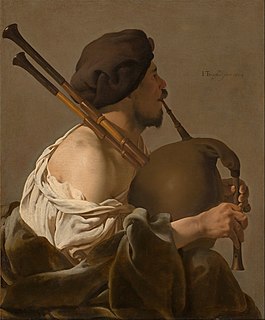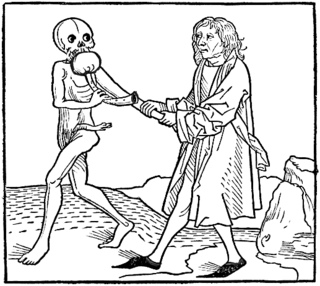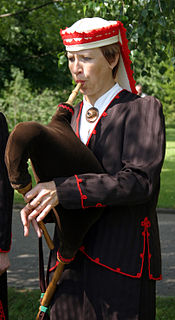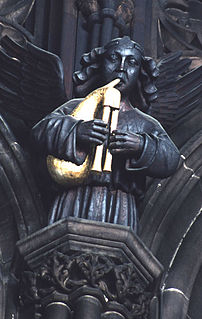Related Research Articles

Bagpipes are a woodwind instrument using enclosed reeds fed from a constant reservoir of air in the form of a bag. The Scottish Great Highland bagpipes are the best known in the Anglophone world; however, bagpipes have been played for a millennium or more throughout large parts of Europe, northern Africa, and western Asia, including Anatolia, the Caucasus, and around the Persian Gulf. The term bagpipe is equally correct in the singular or plural, though pipers usually refer to the bagpipes as "the pipes", "a set of pipes" or "a stand of pipes".

The uilleann pipes are the characteristic national bagpipe of Ireland. Earlier known in English as "union pipes", their current name is a partial translation of the Irish-language term píobaí uilleann, from their method of inflation. There is no historical record of the name or use of the term uilleann pipes before the twentieth century. It was an invention of Grattan Flood and the name stuck. People mistook the term 'union' to refer to the 1800 Act of Union; this is incorrect as Breandán Breathnach points out that a poem published in 1796 uses the term 'union'.

The chanter is the part of the bagpipe upon which the player creates the melody. It consists of a number of finger-holes, and in its simpler forms looks similar to a recorder. On more elaborate bagpipes, such as the Northumbrian bagpipes or the Uilleann pipes, it also may have a number of keys, to increase the instrument's range and/or the number of keys it can play in. Like the rest of the bagpipe, they are often decorated with a variety of substances, including metal (silver/nickel/gold/brass), bone, ivory, or plastic mountings.

The Great Highland bagpipe is a type of bagpipe native to Scotland. It has acquired widespread recognition through its usage in the British military and in pipe bands throughout the world.

The border pipes are a type of bagpipe related to the Scottish Great Highland Bagpipe. It is perhaps confusable with the Scottish smallpipe, although it is a quite different and much older instrument. Although most modern Border pipes are closely modelled on similar historic instruments, the modern Scottish smallpipes are a modern reinvention, inspired by historic instruments but largely based on Northumbrian smallpipes in their construction.

The Galician gaita is the traditional instrument of Galicia and northern Portugal.

Northern England, also known as the North of England or simply the North, is the northern part of England, considered as a single cultural area. It extends from the Anglo-Scottish border in the north to near the River Trent in the south, although precise definitions of its southern extent vary. Northern England approximately comprises three statistical regions: the North East, North West and Yorkshire and the Humber. These have a combined population of around 14.9 million as of the 2011 Census and an area of 37,331 km2. Northern England contains much of England's national parkland but also has large areas of urbanisation, including the conurbations of Greater Manchester, Merseyside, Teesside, Tyneside, Wearside, and South and West Yorkshire.

The Bladder pipe is a medieval simplified bagpipe, consisting of an insufflation tube, a bladder (bag) and a chanter; sounded by a double reed, which is fitted into a reed seat at the top of the chanter. The reed, inside the inflated bladder, is sounded continuously, and cannot be tongued. Some bladder pipes were made with a single drone pipe, and reproductions are similar to a loud, continuous crumhorn. The chanter has an outside tenon, at the top, near the reed, which fits into a socket or stock, which is then tied into the bladder.
Cornish bagpipes are the forms of bagpipes once common in Cornwall in the 19th century. Bagpipes and pipes are mentioned in Cornish documentary sources from c.1150 to 1830 and bagpipes are present in Cornish iconography from the 15th and 16th centuries.

A Lambeg drum is a large Northern Irish drum, beaten with curved malacca canes. It is used primarily in Northern Ireland by Unionists and the Orange Order traditionally in street parades held in the summer, particularly on and around 12 July. The weight of the drum means that it had been replaced with smaller replicas for most parades, but the full-sized instrument has started to reappear in recent years - usually on floats. It is also used by the Ancient Order of Hibernians, having historical significance for parts of the nationalist community, as well.
Gaita may refer to:

The torupill is a traditional bagpipe from Estonia.

The Associação Gaita-de-fole is a non-profit organization, founded officially in 1994 by enthusiasts of the Portuguese folk traditions — specially the related with the Transmontan and Galician bagpipes. The volunteers contribute in a variety of ways, as artisans, musicians, anthropologists and teachers, both professional and amateurs.

The xeremia is a type of bagpipe native to the island of Majorca (Mallorca). It consists of a bag made of skin, known as a sac or sarró which retains the air, a blowpipe (bufador), a melody pipe or chanter (grall), and several, generally three, drones (bordons). The primary drone (roncó) sounds a tonic note, but the other drones are sometimes simply false drones for ornamentation.

When bagpipes arrived in England is unknown, there is some evidence to suggest Anglo-Saxon times, however the oldest confirmed proof of the existence of bagpipes anywhere in the world comes from three separate sources in the 13th century, 2 of them English; The Cantigas Del Santa Maria published in Spain, The Tenison Marginalie Psalter from Westminster and an entry into the accounts books of Edward the I of England recording the purchase of a set of bagpipes. From the 14th century on wards bagpipes start to appear in the historical records of European countries, however half the mentions come from England suggesting Bagpipes were more common in England.

The gaita de boto is a type of bagpipe native to the Aragon region of northern Spain.
It is unclear whether Lincolnshire bagpipes refer to a specific type of pipes native to Lincolnshire, England, or to the popularity of a more general form of pipes in the region. Written records of bagpipes being associated with Lincolnshire date back to 1407, but it is difficult to find certain proof that any regional variation of the bagpipe existed which was peculiar to Lincolnshire. Despite the lack of evidence for a uniquely local instrument, it is clear that the bagpipe was enjoyed by the people of Lincolnshire.
The Lancashire bagpipe or Lancashire greatpipe has been attested in literature, and commentators have noticed that the Lancashire bagpipe was also believed proof against witchcraft.
References
- ↑ JJohn Ogilvie, editor Charles Annandale. The Imperial Dictionary of the English Language: a complete encyclopedic lexicon, literary, scientific, and technological. Blackie & Son, 1882. Pg. 203
- ↑ Schmidt, Gary D. (April 1992). "?Vides festinare pastores: The medieval artistic vision of shepherding and the manipulation of cultural expectation in the Secunda pastorum". Neophilologus. 76 (2): 290–304. doi:10.1007/BF00210177.